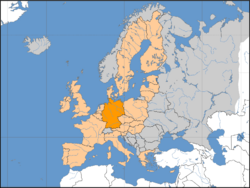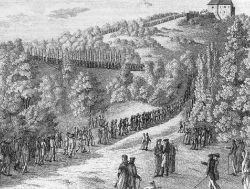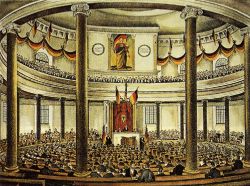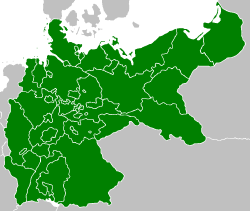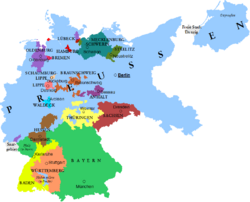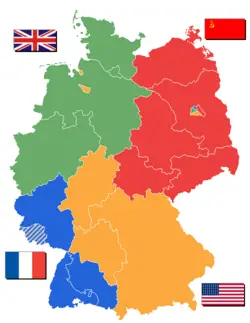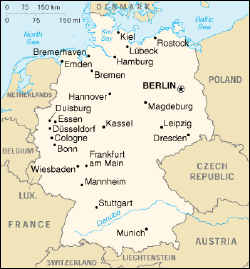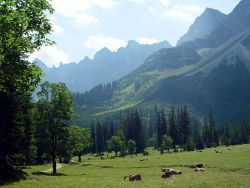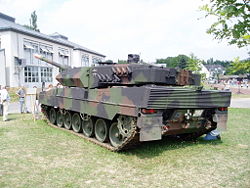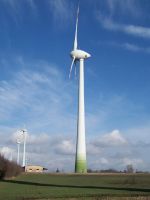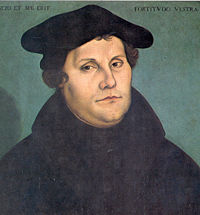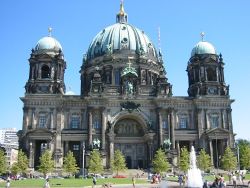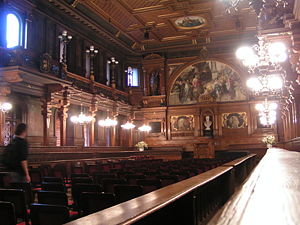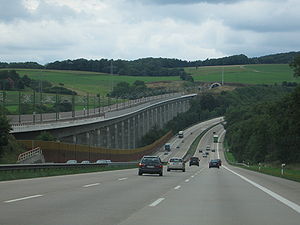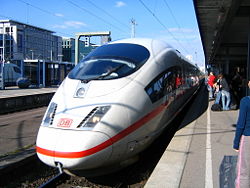Germany
Template:Sprotected
| Bundesrepublik Deutschland Federal Republic of Germany | |||||
| |||||
| Motto: Einigkeit und Recht und Freiheit (German for "Unity and Justice and Freedom”) | |||||
| Anthem: Das Lied der Deutschen (3rd stanza) also called Einigkeit und Recht und Freiheit | |||||
| Capital (and largest city) |
Berlin 52°31′N 13°24′E | ||||
| Official languages | German 1 | ||||
|---|---|---|---|---|---|
| Government | Federal Republic | ||||
| - President | Horst Köhler (CDU) | ||||
| - Chancellor | Angela Merkel (CDU) | ||||
| Formation | |||||
| - Holy Roman Empire | 843 (Treaty of Verdun) | ||||
| - Unification | January 18 1871 | ||||
| - Federal Republic | May 23 1949 | ||||
| - Reunification | October 3 1990 | ||||
| Accession to EU | March 25, 1953 (West Germany) | ||||
| Area | |||||
| - Total | 357,050 km² (63rd) 137,858 sq mi | ||||
| - Water (%) | 2.416 | ||||
| Population | |||||
| - 2005 estimate | 82,438,000 | ||||
| - 2000 census | n/a | ||||
| - Density | 230.9/km² 598.5/sq mi | ||||
| GDP (PPP) | 2005 estimate | ||||
| - Total | $2.522 trillion | ||||
| - Per capita | $30,579 | ||||
| GDP (nominal) | 2005 estimate | ||||
| - Total | $2.797 trillion | ||||
| - Per capita | $33,854 | ||||
| HDI (2003) | 0.930 (high) | ||||
| Currency | Euro (€)2 (EUR)
| ||||
| Time zone | CET (UTC+1) | ||||
| - Summer (DST) | CEST (UTC+2) | ||||
| Internet TLD | .de 3 | ||||
| Calling code | +49 | ||||
| 1 Danish, Low German, Sorbian, Romany and Frisian are officially recognised and protected as minority languages by the ECRML. 2 Prior to 1999 (introduction of the euro as legal tender) and 2002 (introduction of the euro as physical notes and coins): Deutsche Mark. 3 The .eu domain is also used, as it is shared with other European Union member states. | |||||
User:Henry Flower/Map Germany (German: Deutschland IPA: [ˈdɔɪtʃlant]), officially the Federal Republic of Germany (Template:Audio-de, IPA: [ˈbʊndəsrepubliːk ˈdɔɪtʃlant]), is a country in Central Europe. It is bordered to the north by the North Sea, Denmark, and the Baltic Sea, to the east by Poland and the Czech Republic, to the south by Austria and Switzerland, and to the west by France, Luxembourg, Belgium and the Netherlands. Within its borders are a portion of the Alps, the famous Rhine and Danube rivers, and the Black Forest. Its capital is Berlin; many of the governmental institutions, ministries as well as embassies were moved in from the former capital of West Germany, Bonn (now Federal City of Bonn) in 1999.
Germany is a democratic parliamentary federal republic, made up of 16 states (Länder), which in certain spheres act independently of the federation. Historically consisting of several sovereign states with their own history, distinct German tribe dialects, culture and religious beliefs, Germany was unified as a nation state amidst the Franco-Prussian War in 1871.
The Federal Republic of Germany is a member state of the United Nations, NATO, the G8 and the G4 nations, and is a founding member of the European Union. It is the European Union's most populous and most economically powerful member state.
History
The state now known as Germany was unified as a modern nation-state only in 1871, when the German Empire, dominated by the Kingdom of Prussia, was forged. This began the German Reich, usually translated as empire, but also meaning kingdom, domain or realm.
Early history of the Germanic tribes (100 B.C.E. – AD 300)
The ethnogenesis of the Germanic tribes is assumed to have occurred during the Nordic Bronze Age, or at the latest, during the Pre-Roman Iron Age in southern Scandinavia and northern Germany, from the first century B.C.E. expanding south, east and west, coming into contact with Celtic tribes of Gaul and Iranian, Baltic and Slavic tribes in Eastern Europe. Little is known about early Germanic history, except through their interactions with the Roman Empire and archaeological finds.
Under Augustus, the Roman General Drusus began to invade Germany, and it was from this period that the German tribes became familiar with Roman tactics of warfare while maintaining their national identity. In AD 9, three Roman legions led by Publius Quinctilius Varus were crushed by the Cheruscan leader Arminius (Hermann) in the Battle of the Teutoburg Forest. Germany as far as the Rhine and the Danube therefore remained outside the Roman Empire. By 100, the time of Tacitus' Germania, Germanic tribes settled along the Rhine and the Danube (the Limes Germanicus), occupying most of the area of modern Germany. The 3rd century saw the emergence of a number of large West Germanic tribes — Alamanni, Franks, Chatti, Saxons, Frisians, Sicambri, Thuringians. Around 260, the Germanic peoples broke through the Limes and the Danube frontier.
The Holy Roman Empire of German Nation (843-1806)
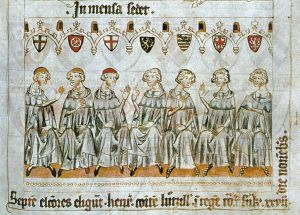
The medieval empire stemmed from a division of the Carolingian Empire in 843, which was founded by Charlemagne on December 25 800, and existed in varying forms until 1806, its territory stretching from the river Eider in the north to the Mediterranean coast in the south. Often referred to as the Holy Roman Empire (or the Old Empire), it was officially called the Holy Roman Empire of the German Nation ("Sacrum Romanum Imperium Nationis Germanicæ") since 1448 to adjust the title to its then reduced territory.
Under the reign of the Ottonian emperors (919–1024), the duchies of Lorraine, Saxony, Franconia, Swabia, Thuringia and Bavaria were consolidated and in 962 the German king was crowned Holy Roman Emperor. Under the reign of the Salian emperors (1024–1125), the Holy Roman Empire absorbed northern Italy and Burgundy. Under the Hohenstaufen emperors (1138–1254) the German princes were increasing their influence further south and east.
The edict of the Golden Bull in 1356 provided the basic constitution of the empire up to its dissolution. For three hundred years starting in 1438, the Emperors were elected nearly exclusively from the Austrian Habsburg family.
In 1530, a separate Protestant church was acknowledged as the new state religion in many states of Germany. This led to inter-German dispute, the Thirty Years' War (1618–1648). From 1740 onwards the dualism between Austria and Prussia dominated the Empire's history. In 1806 the Imperium was overrun and dissolved as a result of the Napoleonic Wars.
Restoration and revolution (1814-71)
Following Napoleon's fall and the end of the Confederation of the Rhine, the Congress of Vienna convened in 1814 in order to restructure Europe. In Germany, the German Confederation was founded, a loose league of 39 sovereign states. Disagreement with the restoration politics partly led to the lifestyle called Biedermeier and to intellectual liberal movements, which demanded unity and freedom during the Vormärz epoch, each followed by a measure of Metternich's repression of liberal agitation. The Zollverein, a tariff union, profoundly furthered economic unity in the German states.
The German people had been stirred by the ideals of the French revolution. On October 18, 1817, students held a gathering to exchange ideas, the high point of which was the burning of works by authors like August von Kotzebue, who were against a united German state. A second such meeting attracted 30,000 people from all social classes and from all regions to the Hambacher celebration. There for the first time, the colours of black, red and gold were chosen to represent the movement, which later became the national colours.
The states were also shaped by the Industrial Revolution, which was the initial step of the growing industrialisation in Europe and contributed to a wave of poverty, causing social uprisings. In light of a series of revolutionary movements in Europe, which in France successfully established a republic, intellectuals and common people started the Revolutions of 1848 in the German states. The monarchs initially yielded to the revolutionaries' liberal demands, and an intellectual National Assembly was elected to draw up a constitution for the new Germany, completed in 1849. However, the Prussian king Frederick William IV, who was offered the title of Emperor but with a loss of power, rejected the crown and the constitution. This prompted the demise of the national assembly along with most of the changes from the revolution.
In 1862, conflict between the Prussian King Wilhelm I and the increasingly liberal parliament erupted over military reforms. The king appointed Otto von Bismarck the new Prime Minister of Prussia. Bismarck solved the conflict with difficulty and used the desire for national unification to further the interests of the Prussian monarchy. In 1864 he successfully waged war on Denmark. Prussian victory in the Austro-Prussian War of 1866 enabled him to create the North German Confederation and divide Austria, formerly the leading state of Germany, from the more western and northern parts.
Second German Empire (1871-1918)
After the French defeat in the Franco-Prussian War, the German Empire (Deutsches Kaiserreich) was proclaimed in Versailles on January 18 1871. As a result, the new empire was a unification of all the scattered parts of Germany but without Austria — Kleindeutschland. Beginning in 1884 Germany established several colonies. The young emperor's foreign policy was opposed to that of Bismarck, who had established a system of alliances in the era called Gründerzeit, securing Germany's position as a great nation, isolating France with diplomatic means and avoiding war for decades. Under Wilhelm II, however, Germany took an imperialistic course, not unlike other powers, but it led to friction with neighbouring countries. Most alliances in which Germany had been previously involved were not renewed, and new alliances excluded the country. Specifically, France established new relations by signing the Entente Cordiale with the United Kingdom, and got ties with Russia. Austria-Hungary and Germany became increasingly isolated.
Although not one of the main causes, the assassination of Austria's crown prince triggered World War I on July 28 1914, which saw Germany as part of the unsuccessful Central Powers in the second-bloodiest conflict of all time against the Allied Powers. In November 1918, the second German Revolution broke out, and Emperor Wilhelm II and all German ruling princes abdicated. An armistice was signed on November 11, putting an end to the war. Germany was forced to sign the Treaty of Versailles in 1919, whose unexpectedly high demands were perceived as humiliating in Germany, as a continuation of the war by other means and a breaking of traditional post-war diplomacy that included negotiations between the victors and vanquished.
Weimar Republic (1919-33)
After the German Revolution in November 1918, a Republic was proclaimed. That year, the German Communist Party was established by Rosa Luxemburg and Karl Liebknecht, and in January 1919 the German Workers Party, later known as the Nationalsozialistische Deutsche Arbeiterpartei (National Socialist German Workers Party, NSDAP, "Nazis"). On August 11 1919, the Weimar Constitution came into effect, with the sign of the Reichspräsident Friedrich Ebert.
In a cool climate of economic hardship from both the world wide Depression and the harsh peace conditions dictated by the Treaty of Versailles, and a long succession of more or less unstable governments, the political masses in Germany increasingly lacked identification with their political system of parliamentary democracy. This was exacerbated by a wide-spread right-wing (monarchist, völkische, and Nazi) Dolchstoßlegende, a political myth which claimed the German Revolution was the main reason why Germany had lost WWI. On the other hand, radical left-wing communists such as the Spartacist League had wanted to abolish what they perceived as a "capitalist rule" in favour of a "Räterepublik" and were thus also in opposition to the existing form of government. During the years following the Revolution, German voters increasingly supported anti-democratic parties, both right- (monarchists, Nazis) and left-wing (Communists). At the beginning of the 1930s, Germany was not far from a civil war. Paramilitary troops were set up by several parties, there were thousands of politically motivated murders. They intimidated voters and seeded violence and anger among the public, who suffered from high unemployment and poverty. After a succession of unsuccessful cabinets, on January 29 1933, President von Hindenburg, seeing little alternative and pushed by advisors, appointed Adolf Hitler Chancellor of Germany.
Third Reich (1933–45)
On 27 February 1933, the Reichstag was set on fire. Some basic democratic rights were quickly abrogated afterwards under an emergency decree. An Enabling Act gave Hitler's government full legislative power — only the Sozial Demokratische Partei, SPD voted against it; the communists could not because many had already been imprisoned or murdered. A centralised totalitarian state was established by a series of moves and decrees making Germany a single-party state. Industry was closely regulated with quotas and requirements in order to shift the economy towards a war production base. In 1936, German troops entered the demilitarised Rhineland and British Prime Minister Neville Chamberlain's appeasement policies proved inadequate. Emboldened, Hitler followed from 1938 onwards a policy of expansionism to establish Greater Germany. To avoid a two-front war, Hitler concluded the Molotov-Ribbentrop Pact with the Soviet Union, and broke it.
In 1939 the growing tensions from nationalism, militarism, and territorial issues led to the Germans launching a blitzkrieg on September 1st against Poland, followed two days later by declarations of war by Britain and France, marking the beginning of World War II. Germany quickly gained direct or indirect control of the majority of Europe. On June 22, 1941, Hitler broke the pact with the Soviet Union by opening the Eastern Front and invading the Soviet Union. Shortly after Japan attacked the American base at Pearl Harbor, Germany declared war on the United States. Although initially the German army rapidly advanced into the surprised Soviet Union, the Battle of Stalingrad marked a major turning point in the war. Subsequently, the German army commenced retreating on the Eastern front, followed by the eventual defeat of Germany. On 8 May 1945, Germany surrendered after the Red Army occupied Berlin.
In what later became known as The Holocaust, the Third Reich regime enacted governmental policies directly subjugating many parts of society: Jews, Slavs, Roma, homosexuals, freemasons, political dissidents, priests, preachers, religious opponents, and the disabled, amongst others. During the Nazi era about 11 million people were murdered in the Holocaust, including more than 6 million Jews.
Division and reunification (1945-90)
The war resulted in the death of several million German soldiers and civilians, in total nearly ten million, large territorial losses and the expulsion of about 15 million Germans of the eastern provinces of Germany and various parts of Central and Eastern Europe with ethnic German population. All major and many smaller German cities lay in ruins. Germany and Berlin were occupied and partitioned by the Allies into four military occupation zones controlled by France, the United Kingdom, the United States, and the Soviet Union. On May 23 1949, the U.S, Britain and France united their individual sectors to form the democratic nation of the Federal Republic of Germany and on October 7 1949 the Soviet Zone established the German Democratic Republic, In English the two states were known informally as "West Germany" and "East Germany" (with historical eastern Germany having fallen to Poland and the Soviet Union) respectively.
West Germany, established as a liberal parliamentary republic with a "social market economy", was allied with the United States, the UK and France. After the ideological switch in U.S. occupation policy away from economic dismantlement and towards reconstruction, which was heralded by the "Speech of hope" in September of 1946, the country eventually came to enjoy prolonged economic growth beginning in the early 1950's (Wirtschaftswunder). The recovery was largely because of the previously forbidden currency reform of June 1948 and U.S. assistance through the Marshall Plan aid. West Germany joined NATO in 1955 and was a founding member of the European Economic Community in 1958. Across the border, East Germany was at first occupied by and later (May 1955) allied with the USSR. An authoritarian country with a Soviet-style command economy, East Germany soon became the richest, most advanced country in the Warsaw Pact, but many of its citizens looked to the West for political freedoms and economic prosperity. Relations between East Germany and West Germany remained icy until the Western Chancellor Willy Brandt launched a highly controversial approchement policy with the East European communist states (Ostpolitik) in the early 1970s. This led to a form of mutual recognition between East and West Germany.
During the summer of 1989, rapid changes took place in East Germany, which ultimately led to German reunification. Growing numbers of East Germans migrated to West Germany via Hungary and clandestinely through the border separating East from West Germany. The exodus generated demands within East Germany for political change, and mass demonstrations with eventually hundreds of thousands of people in several cities continued to grow. In the face of these events, East German authorities unexpectedly eased the border restrictions in November 1989, allowing East German citizens to travel to the West. This led to the acceleration of the process of reforms in East Germany that ended with German reunification on October 3 1990. Under the terms of the treaty between West and East Germany, Berlin again became the capital of the reunited Germany.
Administrative divisions
Germany is divided into 16 states (in German called Länder, singular Land; commonly Bundesländer, singular Bundesland). It is further subdivided into 439 districts (Kreise) and cities (kreisfreie Städte) (2004). There is a list of all Administrative Divisions of Germany.
The ten largest cities in Germany (population as of March 31, 2005):
- Berlin (capital of Germany) with 3,396,990 inhabitants
- Hamburg with 1,744,215 inhabitants
- Munich (in German: München) with 1,397,537 inhabitants
- Cologne (Köln) with 975,907 inhabitants
- Frankfurt am Main with 660,289 inhabitants
- Stuttgart with 591,548 inhabitants
- Dortmund with 588,680 inhabitants
- Essen with 588,084 inhabitants
- Düsseldorf with 578,821 inhabitants
- Bremen with 546,932 inhabitants
The five largest metropolitan areas in Germany (population as of January 1, 2005) are listed below. Metro area populations are always controversial, and these figures are based on a broad interpretation of the term. They are better seen as being for metropolitan regions than metropolitan cities.
- Rhein-Ruhr with 11,785,196 inhabitants
- Frankfurt Rhein-Main Region with 5,822,383 inhabitants
- Berlin with 4,262,480 inhabitants
- Hamburg with 3,278,635 inhabitants
- Stuttgart with 2,344,989 inhabitants
| In English | Auf Deutsch (In German) | |||
|---|---|---|---|---|
| State | Capital | Land | Hauptstadt | |
| 1 | Baden-Württemberg | Stuttgart | Baden-Württemberg | Stuttgart |
| 2 | (Free State of) Bavaria | Munich | (Freistaat) Bayern | München |
| 3 | Berlin | Berlin | Berlin | Berlin |
| 4 | Brandenburg | Potsdam | Brandenburg | Potsdam |
| 5 | (Free Hanseatic City of) Bremen | Bremen | (Freie Hansestadt) Bremen | Bremen |
| 6 | (Free and Hanseatic City of) Hamburg | Hamburg | (Freie und Hansestadt) Hamburg | Hamburg |
| 7 | Hesse | Wiesbaden | Hessen | Wiesbaden |
| 8 | Mecklenburg-Western Pomerania | Schwerin | Mecklenburg-Vorpommern | Schwerin |
| 9 | Lower Saxony | Hanover | Niedersachsen | Hannover |
| 10 | North Rhine-Westphalia | Düsseldorf | Nordrhein-Westfalen | Düsseldorf |
| 11 | Rhineland-Palatinate | Mainz | Rheinland-Pfalz | Mainz |
| 12 | Saarland | Saarbrücken | Saarland | Saarbrücken |
| 13 | (Free State of) Saxony | Dresden | (Freistaat) Sachsen | Dresden |
| 14 | Saxony-Anhalt | Magdeburg | Sachsen-Anhalt | Magdeburg |
| 15 | Schleswig-Holstein | Kiel | Schleswig-Holstein | Kiel |
| 16 | (Free State of) Thuringia | Erfurt | (Freistaat) Thüringen | Erfurt |
Geography
Germany is located in Central Europe and it shares borders with Denmark in the North, Netherlands, Belgium, Luxembourg and France in the West, Austria and Switzerland in the South and Poland and the Czech Republic in the East. The North Sea and the Baltic Sea represent additional National Borders in the North.
Geographic coordinates: 51°00′N 9°00′E
Area
Territory
Since reunification Germany has resumed its role as a major centre country between Scandinavia in the north and the Mediterranean region in the south, as well as between the Atlantic west and the countries of Central and Eastern Europe.
The territory of Germany stretches from the high mountains of the Alps (highest point: the Zugspitze at 2,962 m / 9,718 ft) in the south to the shores of the North Sea (Nordsee) in the north-west and the Baltic Sea (Ostsee) in the north-east. In between are the forested uplands of central Germany and the low-lying lands of northern Germany (lowest point: Neuendorfer/Wilstermarsch at 3.54 metres (11.6 ft) below sea level), traversed by some of Europe's major rivers such as the Rhine, Danube and Elbe.
Because of its central location, Germany shares borders with more European countries than any other country in Europe. Its neighbours are Denmark in the north, Poland and the Czech Republic in the east, Austria and Switzerland in the south, France and Luxembourg in the south-west and Belgium and the Netherlands in the north-west.
Climate
(→ see also commons:Category:Climate diagrams of Germany (FR))
The greater part of Germany lies in the cool/temperate climatic zone in which humid westerly winds predominate.
The climate is influenced to some extent by the Gulf Stream, which promotes an unusually mild climate in areas adjacent to it. The climate in Great Britain, Portugal, France and Norway is especially influenced by this stream and to a lesser extent the areas bordering on the North Sea including the peninsula of Jutland in north Germany and the area along the Rhein which flows into the North Sea.
In the north-west and the north the climate is oceanic and rain falls all year round. Winters there are relatively mild and summers tend to be comparatively cool, even though temperatures can reach above 30 degrees Celsius (86 °F) for prolonged periods of time. Average temperatures: Hamburg: January 0.3 °C (33 °F) / July 17.1 °C (63°F); Essen: January 1.5 °C (35 °F) / July 17.5 °C (64 °F)
In the east the climate shows clear continental features; winters can be very cold for long periods, and summers can become very warm. Here, too, long dry periods are often recorded. Average temperatures: Berlin: January −0.9 °C (30 °F) / July 18.6 °C (65 °F)
In the central part and the south there is a transitional climate which varies from moderately oceanic to continental, depending on the location. Hot summers with temperatures about 30 degrees Celsius (86 °F) are possible. Average temperatures: Munich: January −2.2 °C (28 °F) / July 17.6 °C (64 °F); Freiburg: January 1.2 °C (34 °F) / July 19.4 °C (67 °F)
Demographics

Because of the country's federal and decentralised structure Germany has a number of larger cities. The most populous are Berlin, Hamburg, Munich, Cologne, Frankfurt and Stuttgart. By far the largest conurbation is the Rhine-Ruhr region, including the Düsseldorf-Cologne district and the cities of Essen, Dortmund, Duisburg and Bochum. The federal structure has kept the population oriented towards a number of large cities, and has precluded the growth of any single city that would rival such European capitals as London, Paris or Moscow for size.
As of December 2004, about 7 million foreign citizens are registered in Germany and 19% of the country's residents are of foreign or partially foreign descent, the majority are Turkish, or are from Italy, Yugoslavia, and other European states.[2] In its State of World Population 2006 report, the United Nations Population Fund lists Germany with hosting the third-highest percentage of international migrants worldwide, about 5% or 10 million of all 191 million migrants.[3]
Because of modifications to Germany's traditionally rather unrestricted laws on asylum and immigration in the years around 2000, the number of annual asylum seekers as well as on immigrants based on German ethnicity (mostly from the former Soviet Union) has been declining since then.
Germany faces major demographic change, as its birth rate being one of the lowest in the world. The federal statistics office estimates the population will shrink to approximately 75 million by 2050, with ethnic Germans risking displacement by foreigners with higher birthrates. Questions remain as to how Germany will pay for the sustenance of immigrants, in addition to its own aging population.[1] Chemnitz is thought to be city with the lowest birth rate in the world.[4]
There are 2.2 million Turks in Germany, 139,000 of them in Berlin alone, making them the largest group of foreign workers.
Economy
Germany is the largest European economy and the third largest economy in the world in real terms, placed behind the United States and Japan, and fifth behind the United States, the People's Republic of China, India and Japan counted by purchasing power parity. According to the World Trade Organization, Germany is also the world's top exporter, ahead of the United States and number two in imports. It currently (2005) has the largest trade surplus in the world (160.6 billion euros). While it has positive trade balances with most of its EU-partners (+129.8 billion euros / 2005) and the United States (+28 billion euros / 2005), it runs trade deficits with China (-18.6 billion euros / 2005), Japan (-8.1 billion euros /2005) and Russia (-4.3 billion euros / 2005). With a net international investment position of 545.9 billion euros (US$682 billion) in Q2 2006 (Deutsche Bundesbank), Germany is the second largest international creditor behind Japan.
A major issue of concern remains the persistently high unemployment rate and weak domestic demand which slows down economic growth. Eastern Germany in particular suffers from a lack of a solid base of small and medium-sized companies, which provided the foundation for the Federal Republic's economic prosperity and is responsible in great measure for Germany's lag in economic growth. In spite of its extremely good performance in international trade domestic demand has stagnated for many years because of wage stagnation and zealous cost-cutting by the federal state. Insecurity among consumers has caused many of the prevalent economic problems. Germany's government runs a restrictive fiscal policy and has cut numerous regular jobs in the public sector. Since reunification there has been a net loss of estimated one million such jobs. But while regular employment in the public sector shrank, "irregular" government employment such as "one-euro jobs" (jobs paid this amount per hour on top of unemployment benefits), government supported self-employment (known informally as "Ich-AG", or "Me, Inc.") and job training increased. Despite the tense situation in eastern Germany, total government employment in Germany remains lower than in other states such as the United Kingdom or Canada.
Economical and political discussion in Germany today concentrates on whether Germany needs more market reforms such as deregulation of the labour market, more low income jobs, lower social security contributions, lower taxes for enterprises and employers, or already passed too many reforms. In view of problematic socio-economic trends (fast growing inequality, rising poverty rates, stagnant wages, less social security, constant high unemployment) corporate profits and salaries of top managers soar. More and more people in Germany distrust the sense and direction of the reforms over the last years. A major reason is the pressure that unions and lobbyists exert on parliament. One third of the lower house (Bundestag) are themselves in one union or another. Many representatives of the upper house (Bundesrat) and lower house are at the same time on the advisory council (Aufsichtsrat) of major concerns in the pharmaceutical, energy and automobile sectors leading to exploding costs for the consumer in these areas.
See also below: Science and technology
Exports
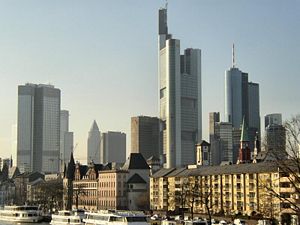
As mentioned above the export of goods is an essential part of the German economy and one of the most relevant reasons for Germany's wealth. Like many other export oriented countries, Germany itself does not have the climate or the natural resources necessary to support a high living standard. Overtaking the United States in 2003, Germany is now the world's largest exporter of goods with $1.016 trillion exported in 2005 (Germany's exports to other euro zone countries are included in this total). In export of services (tourism, financial services, engineering...) it ranks third behind the United States and the United Kingdom. Altogether it's the second largest exporter behind the United States.
Although most of its exports are in engineering (such as cars, machinery, chemical goods, and optics), Germany also has a strong position in the export of microelectronics, which, according to the WTO, account for 15 percent of German exports. Germany sells nearly twice as many such products per capita than the United States, significantly more than Japan and nearly the same as the United Kingdom.
Politics
Germany's political system is a framework of a federal parliamentary representative democratic republic, whereby the Chancellor is the head of government, and of a pluriform multi-party system. Executive power is exercised by the government. Federal legislative power is vested in both the government and the two chambers of parliament, Bundestag and Bundesrat. While the Bundestag is elected in direct election the Bundesrat represents the governments of the 16 German States. Since 1949 the party system is dominated by the conservative Christian Democratic Union and the Social Democratic Party of Germany. Smaller parties that have an important role are the liberal Free Democratic Party, that has been in the Bundestag since 1949, as well as the Green Party that has had seats in the parliament since 1983.
The German head of state is the President of Germany, elected by an institution consisting of Bundesrat and Bundestag (called Bundesversammlung which means federal convention). The second highest official in the German order of precedence is the President of the Bundestag elected by the Bundestag itself. He is responsible for the parliaments sessions and the regularity of the institution. The third highest official is the chancellor as the head of government recommended by the President of Germany, elected by the Bundestag and if necessary removed by a constructive motion of no confidence of the Bundestag. Constructive motion meens that the Bundestag has to elect a successor.
The Judiciary of Germany is independent of the executive and the legislature. The political system is laid out in the 1949 constitutional document under approval of the allied forces which wanted to assure among other restrictions that Germany's military forces are restricted exclusively to defence and that a dictatorship could not reoccur. It is known as the Grundgesetz literally Basic Law. It is akin to the American Constitution. Changes in the Grundgesetz require a majority of two thirds of both chambers of the parliament. The Grundgesetz remained in effect with minor amendments after 1990's German Reunification.
Legal system
Germany has a civil or statute law system based ultimately on Roman law with some references to Germanic law. Legislative power is divided between the Federation and the individual federated states. While criminal law and private law have seen codifications on the national level (in the Strafgesetzbuch and the Bürgerliches Gesetzbuch respectively), no such unifying codification exists in administrative law where a lot of the fundamental matters remain in the jurisdiction of the individual federated states. In 1976, with the Verwaltungsverfahrensgesetz (VwVfG), the main form of actions of administration was codified. Most federated states have followed this codification. There are a series of special supreme courts; for civil and criminal cases the highest court of appeal is the Bundesgerichtshof (Federal Court of Justice), located in Karlsruhe. The courtroom style is inquisitorial.
The Federal Constitutional Court (Bundesverfassungsgericht), also located in Karlsruhe, is the German Supreme Court responsible for constitutional matters, with power of judicial review. It acts as the highest legal authority and ensures that legislative and judicial practice conforms to the Constitution. It acts independently of the other state bodies, but cannot act on its own behalf.
Foreign relations
Germany plays a leading role in the European Union, having a strong alliance with France. Germany is at the forefront of European states seeking to advance the creation of a more unified and capable European political, defence and security apparatus.
Since its establishment on May 23, 1949, the Federal Republic of Germany kept a notably low profile in international relations, because of both its recent history and its occupation by foreign powers. In 1999, however, on the occasion of the NATO war against Yugoslavia, Chancellor Gerhard Schröder's government broke convention by sending German troops into combat for the first time since World War II.
Germany and the United States have been close allies since the end of the Second World War. The Marshall Plan and continued US support during the rebuilding process after World War II, as well as the significant influence American culture has had on German culture, have crafted a strong bond between Germany and the US that lasts to this day. Not only do the United States and Germany share many cultural similarities: they are also deeply economically interdependent. Of all German exports, 8.8% are US-bound, and US–German trade in 2004 totalled $108.2 billion. An illustration of the strong economic relations between the US and Germany may be the fact that 18.3% of all cars sold in the US were manufactured by German car makers. Other signs of the close ties between Germany and the US are the continuing status German-Americans as the largest ethnic group in the US and the status of Ramstein Air Base, close to the city of Kaiserslautern, Germany, as the largest US community outside the US.
Armed forces
Germany's military, the Bundeswehr, is a defence force with Heer (German Army), Marine (German Navy), Luftwaffe (German Air Force), Zentraler Sanitätsdienst (Central Medical Services) and Streitkräftebasis (Joint Service Support Command) branches. It employs some 250,000 soldiers (including women in active fighting branches since 2001) and 120,000 civilians (will be reduced to 75,000). 40,000 of the soldiers are 18–23-year-old men on national duty, currently for at least 9 months. In peacetime, the Bundeswehr is commanded by the Minister of Defence, currently Franz Josef Jung. If Germany goes to war, which according to the constitution is allowed only for defensive purposes, the Chancellor becomes commander in chief of the German Bundeswehr.
Currently, the German military has about 1,180 troops stationed in Bosnia-Herzegovina; 2,650 Bundeswehr soldiers are serving in Kosovo; 780 soldiers are stationed as a part of EUFOR in the Democratic Republic of the Congo; 2,400 soldiers are serving in a navy battle group off the coast of the Lebanon as a part of UNIFIL and 3,900 Bundeswehr troops are assisting the US anti-terrorism operation called Enduring Freedom off the Horn of Africa. 4,500 German troops currently make up the largest contingent of the NATO-led ISAF force in Afghanistan.
Energy policy
In 2000, the German SPD-led government along with Bündnis 90/Die Grünen (Alliance '90/The Greens), officially announced its intention to phase out the use of nuclear energy. Jürgen Trittin as the Minister of Environment, Nature Conservation and Nuclear Safety, reached an agreement with energy companies on limiting the life span of the existing nuclear power plants and an end to the civil usage of nuclear power by 2020. See also: the country's nineteen nuclear power plants
In 1999, electricity production in Germany was powered by coal (47%), nuclear power (30%), natural gas (14%), renewable sources (including hydro, wind and solar power) (6%), and oil (2%) ([5]). As for energy consumption, oil accounted for 41% of the total. At the World climate conference, the German government announced a carbon dioxide reduction target of 25% by the year 2005 as compared to 1990, to protect global climate.[5] Note however, that the 1990 numbers included former industrial facilities in eastern Germany, most of which soon expired in post-1990-Germany.
In 2005, the German government reached an agreement with Russia in building a gas pipeline along the bottom of the Baltic Sea directly from Russia to Germany. Bypassing Poland and other Baltic countries lead to controversy.
Due in part to generous subsidies Germany leads Europe by having the greatest capacity on the continent to generate electricity from sun and wind.[6] In terms of total installed capacity to generate electricity from windpower Germany is No.1 in the world. By 2005 it had a capability to generate 18,427.5 MW (in comparison: 2nd place Spain — 10,027 MW; 3rd place; USA — 9,141 MW). Because of the whims of wind and sun and the reluctance of the conventional energy companies to transmit renewable energy on their transmission lines the power actually generated seldom reaches the capacity to produce it. Since the environmentalistists have been voted out of government and the end of subsidies in 2006 the number of new wind generators to be installed in Germany has dropped dramatically. However, Germany's emphasis on renewable energy sources has resulted in the founding of numerous high-tech companies developing such technologies. Germany is also the main exporter of wind turbines, the demand greatly exceeding capacity.[7]
Society
Religion
Germany is the home of the Reformation launched by Martin Luther in the early 16th century. Today, Protestants (particularly in the north and east) comprise about 33% of the population and Roman Catholics (particularly in the south and west) also 33%. The current Roman Catholic Pope, Benedict XVI, was born in Bavaria. In total more than 55 million people officially belong to a Christian denomination.
The third largest religious identity in Germany, after the two Christian groups, is that of non-religious people (including atheists and agnostics (especially in former GDR)), who amount to a total of 28.5% of the population (23.5 million).
Approximately 3 million Muslims [6] (predominantly from Turkey and some from the former Yugoslavia) live in Germany. Most are Sunnis and Alevites from Turkey but there are a small number of Shiites.
Today's Germany has Western Europe's third-largest Jewish population. In 2004, twice as many Jews from former Soviet republics settled in Germany as in Israel, bringing the total influx to more than 200,000 since 1991. About half joined a settled Jewish community, of which there are now more than 100, with a total of 100,000 members — up from 30,000 before reunification. Some German cities have seen a revival of Jewish culture, particularly in Berlin, where there are also 3,000 Israelis. Jews have a strong voice in German public life through the Zentralrat der Juden in Deutschland (Central Council of Jews in Germany). Other cities with significant Jewish populations are Frankfurt and Munich.
Social issues
The German social market economy (German: soziale Marktwirtschaft) helped bring about the "economic miracle" (the German "Wirtschaftswunder") that rebuilt Germany from rubble after World War II to one of the most impressive economies in Europe. Still today, Ludwig Erhard, minister of economics in the Adenauer administration (1949–1963) and later chancellor (1963–1966), is widely recognised as having been the "father" of this profound rise in the country's economic and social wealth.
Germany continues to struggle with a number of social issues, although problems created by the German Reunification of 1990 have begun to diminish. The standard of living is higher in the western half of the country, but easterners now share a reasonably high standard of living. Germans continue to be concerned about a relatively high level of unemployment, especially in the former East German states. The country has passed several reforms to curb unemployment. Recent polls have indicated a growing poverty in the country. In spring of 2006 it had reached 8% of the population, in the easten part as high as 20% according to the FES (Friedrich-Ebert Stiftung).
For centuries, a woman's role in German society was summed up by the three words: Kinder (children), Küche (kitchen), and Kirche (church) — Kinder, Küche, Kirche. Throughout the twentieth century, however, women have gradually won victories in their quest for equal rights. Despite significant gains, discrimination remains in united Germany. Women are noticeably absent in the top tiers of German business. They only hold 9.2% of jobs in Germany's upper and middle management positions.[8] Until 2001 women were barred from serving in combat units in the Bundeswehr, being restricted to the medical service and the administration. The first woman to become chancellor is Angela Merkel, who was elected in 2005.
Since World War II, Germany has experienced intermittent turmoil from various groups. In the 1970s leftist terrorist organisations like the Red Army Faction engaged in a string of assassinations and kidnappings against political and business figures and there has been a recent surge in right-wing nationalist crimes. According to former Interior Minister Otto Schily, the number of these crimes rose 8.4% to 12,553 cases in 2004, which the minister attributed to such crimes as the display of illegal Nazi symbols being reported more frequently.[citation needed]
As mentioned elsewhere in this article population growth is burdened with an extremely low fertility/birthrate. Currently Germany's average birth rate has plunged to less than 1.4 children per mother, a situation which would lead to the demise of any species if nothing is undertaken to relieve it. Lawmakers ask what the state can do to encourage women to have more children. According to provisional figures from the Federal Statistics Office, 680,000 babies were born in Germany in 2005, down from a peak of 1.36 million in 1964 and fewer even than in 1945, when nearly all the country lay in rubble.
Germany has failed to implement EU laws prohibiting racial discrimination. The European Court of Justice ruled on April 29 2005, that Germany had breached EU law by failing to transpose fully the 'Racial Equality Directive' prohibiting discrimination on the grounds of race or ethnic origin (Directive 2000/43/EC). Immigrants to Germany may generally face integration issues and other difficulties. In addition to the challenges of adapting to a new language and culture, they may be subject to security-related police inquiries and violence from right-wing nationalist groups.
Some German states have banned Muslim teachers from wearing headscarves in class and all except Bavaria have banned crosses from the classroom as well, generally by prohibiting the use of all religious symbols by teachers. This is legitimate by combining the German states' privilege of educational laws with the principle of separation of church and state, both provided for in the German federal constitution: According to this legal view, teachers in their vocational function within a state administered educational system are obliged to maintain and publicly exhibit religious neutrality when on duty. As this status of employment does not hold for pupils, whose constitutional right to religious freedom thus remains unencumbered by these provisions, this ban cannot legally be extended to them as it is in France.
Education
Germany has one of the world's highest levels of education and many famous universities. The most important foreign languages taught at school are English, French, Latin, Italian and Spanish. Some languages, such as Russian, Ancient Greek, Turkish, Chinese, Japanese, Polish and Arabic are taught less widely. Since the end of World War II, the number of youths entering universities has more than tripled, but university attendance still lags behind many other European nations because of its very high standards. In the annual league of top-ranking universities compiled by Shanghai Jiaotong University in 2004, Germany came 4th overall, with 7 universities in the top 100 (to compare, the United States had 51 in the top 100, but a lot of more universities generally, so that the proportional comparison precipates very well). The highest ranking university, at #45, was the TU Munich. Most German universities are state-owned and were free of charge, however a recently passed education reform calls for fees between €300 and €500 per semester from each student, started in 2006 in the first state (Niedersachsen). Additionally university students are often supported by the so called BAföG, a federal subsidy, running as high as €290 per month as interest free credit plus €290 as direct payment.
Germany (along with [[austria] and switzerland) has a special system of apprenticeship called "Duale Ausbildung" in which apprentices learn in a company as well as state-run school.
German educational ideals differ considerably from Anglo-Saxon educational ideals, emphasising socialisation, debate, vocal participation in class and critical faculties. The results of the PISA student assessments, that revealed comprehension of the respective subject matters only, were a shock to the German public but no surprise to many educational experts. In the test of 31 countries in year 2000 Germany ranked 21st in reading and 20th in both Mathematics and in the Natural Sciences.
Participation in the official school system is compulsory; however, home-schooling is still practised by a small number of people. There has been some publicity to government prosecution of this practice.
Culture
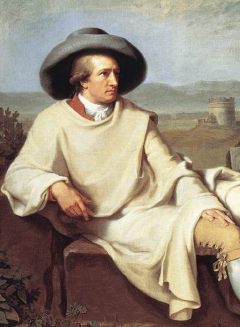
Germany's contributions to the world's cultural heritage are numerous, and the country is often known as das Land der Dichter und Denker (the land of poets and thinkers). German literature can be traced back to the Middle Ages, in particular to such authors as Walther von der Vogelweide and Wolfram von Eschenbach, considered some of the most important poets of medieval Europe. The fairy tales by Jacob and Wilhelm Grimm are world famous and the Nibelungenlied, whose author is not known, is also a major contribution to German literature. The Thidrekssaga with similar sources is more based in the north european area. Theologian Luther, who translated the Bible into German, is widely credited for having set the basis for modern "High German" language. The most admired German poets and authors are Lessing, Goethe, Schiller, Kleist and Hoffmann. Other poets include Friedrich Hölderlin, Heinrich Heine, Annette von Droste-Hülshoff, Theodor Fontane, Rainer Maria Rilke and authors of the 20th century include Nobel Prize winners Thomas Mann, Hermann Hesse, Heinrich Böll and Günter Grass. Other famous authors are Brecht and Schmidt. Germany's influence on world philosophy was significant as well, as exemplified by Magnus, Leibniz, Kant, Herder, Mendelssohn, Novalis, Fichte, Hegel, Marx, Engels, Feuerbach, Schopenhauer, Schweitzer, Nietzsche, Husserl, Hartmann, Jaspers, Luxemburg, Heidegger, Arendt, Steiner, Gadamer and Habermas. In the field of sociology influential German thinkers were Tönnies, Simmel, Weber, Horkheimer, Adorno and Luhmann.
Many historical figures, though not citizens of Germany in the modern sense, were important and influential figures in German culture, such as Wolfgang Amadeus Mozart, Franz Kafka and Stefan Zweig.
German language
The German language was once the lingua franca of central, eastern and northern Europe. Within the European Union, German is the language with the most native speakers, with more than English, French, Spanish and Italian, because the borders of the German language reach through Austria, Italy, Belgium, Denmark, Luxembourg, the Netherlands and into Switzerland. As a foreign language, German is the third most taught worldwide.[7] It is also the second most used language on the Internet after English. The language has its origin in Old High German which is related to old English. There are numerous dialects of German, many of which are not intelligible to speakers of standard German or a different dialect. Some consider Low German to be a different language from High German; Low German has been given the status of a minority language by the European Union, although it is less used today in the traditionally Low German-speaking areas of northern Germany. Other dialects, which are very different from standard German are spoken in Saxony, Bavaria, Rhineland-Palatinate and Swabia. The Pennsylvania Dutch, spoken by the Amishe is derived from the dialect spoken in the Rhineland-Palatinate.
Music
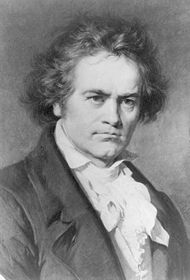
In the field of music, Germany's influence is noted through the works of, among others, Bach, Händel, Telemann, Beethoven, Mendelssohn Bartholdy, Mozart, Brahms, Schumann, Wagner, Strauss, Orff.
Science and technology
Germany is a leading nation in scientific research and the production of innovative technological products. Some of the most important industrial contributions include automobiles, rocketry, material science, and chemical products.
As in physics and chemistry, Germans are a leading nation in the Nobel Prizes for physiology or medicine. In spite of past achievements of their ideals young scientists are currently emigrating at the rate of over 2000 per month (26,000 in 2005). Assumed reasons are overwhelming bureaucracy and a bleak outlook for their future.
Germany has been the homeland of many great scientists like Helmholtz, Fraunhofer, Fahrenheit, Kepler, Haeckel, Wundt, Virchow, Ehrlich, Humboldt, Röntgen, Braun, Einstein, Born, Planck, Heisenberg, Creuzfeldt, Hertz, Koch, Hahn, Leibniz, Liebig, Ostwald, Haber, Mayr and Bunsen.
It has been the home of many inventors and engineers such as Gutenberg, Otto, Geiger, Fick, Lilienthal, Junkers, Reis, von Ardenne, von Mayenburg, Bosch, Bentz, von Drais, Zeppelin, Krupp, Siemens, von Braun, Porsche, Maybach, Daimler, Zuse, Diesel and Benz.
Important mathematicians were born in Germany such as Dedekind, Bessel, Gauß, Hilbert, Jacobi, Riemann, Riese, Klein, Cantor, Weierstraß and Weyl.
With the construction of the first laboratory for psychology at the University of Leipzig in 1879 , Wilhelm Wundt established psychology as an independent empirical science. Important psychologists were born in Germany such as Wundt, von Helmholtz, Charlotte Bühler, Karl Bühler, Heckhausen.
Transport
Because of Germany's central situation in Europe, the volume of traffic, especially goods transit, is very high. In the past decades, much of the freight traffic shifted from rail to road transport, which led the Federal Government to introduce a motor toll for trucks in 2005. In addition, individual traffic increased to an extent that on German roads, traffic densities are very high by international comparison. For the future, a further strong increase of traffic is expected.
High-speed vehicular traffic has a long tradition in Germany, not only owing to the automobile industry, but also, because the first motorway (Autobahn) in the world, the AVUS, and the world's first automobile were developed and built by Carl Benz in Germany. Germany possesses one of the densest road systems of the world. It covers 12,037 kilometres (7,479 mi) of federal "Autobahn" motorways and 41,386 kilometres (25,716 mi) of federal highways. In contrast to other European countries, German motorways partially have no blanket speed limit. However, signposted limits are in place on many dangerous or congested stretches, and where traffic noise or pollution poses a nuisance; some of these limits apply only at night or only in wet conditions.
Another way to travel is via rail. Deutsche Bahn (German Rail) is the major German railway infrastructure and service operator. For commuter and regional services, franchises of various sizes are granted by the individual states, though largely financed from the federal budget. Unsubsidised long-range service operators can compete freely all over the country, at least in theory. Actually, Deutsche Bahn holds a de facto monopoly on long-range services.
The InterCity Express or ICE is a type of high-speed train operated by Deutsche Bahn in Germany and neighbouring countries, for example to Zürich, Switzerland or Vienna, Austria. ICE trains also serve Amsterdam (The Netherlands) as well as Liège and Brussels (Belgium). In spite of branch lines progressively being closed for at least the last seven decades, the rail network throughout Germany is still very extensive and provides excellent services in most areas. On regular lines, at least one train every two hours will call even in the smallest of villages. Nearly all larger metropolitan areas are served by an S-Bahn heavy rail metro system. A large proportion of towns feature underground and/or tram systems. Good urban and overland bus services are ubiquitous.
Frankfurt International Airport is a major international airport and European transportation hub. Frankfurt Airport ranks among the world's top ten airports and serves 304 flight destinations in 110 countries. Depending whether total passengers, flights or cargo traffic are used as a measure, it ranks as the busiest, second busiest and third busiest in Europe. alongside London Heathrow Airport and Paris's Charles de Gaulle.
Germany's second important international airport is Munich International Airport; other major airports are Düsseldorf International Airport, Berlin, Hamburg Airport and Cologne Bonn Airport. Travelling by plane within Germany is unusual due to the extensive network of motorways and railway services.
International rankings
For an explanation of the ratings, see the corresponding article.
Political and economic rankings
- Political freedom — Free; political rights and civil liberties both rated 1 (the highest score available)
- Press freedom — 18th freest in the world at 4.00
- GDP per capita (PPP) — 17th highest in the world at I$30,579
- Human Development Index — 20th highest in the world at 0.930
- Income equality — 14th most equal income at 28.3 (Gini index)
- Literacy rate — Equal 1st with 99.9%
- Unemployment rate — 80th lowest with 10.60%
- Corruption — 16th lowest with a rating of 8.2
- Economic freedom — Equal 19th freest with a rating of 1.96
Health rankings
- Fertility rate — 171st most fertile country with a rating of 1.39 per woman
- Birth rate — 192nd most births per capita at 8.33 per 1000 people
- Infant mortality — 11th least infant deaths with a rating of 4.16 per 1000 births
- Death rate — 55th highest with a rating of 10.55 deaths per 1000 people
- Life expectancy — 23rd highest with 78.80 years
- Suicide rate — 28th highest with 20.4 for men, 7.0 for women and 13.5 total
Other rankings
- CO2 emissions per capita — 34th highest with 9.8 metric tons per capita
- Electricity consumption — 7th highest with 510,400,000,000 kWh
- Broadband uptake — 18th highest with 13.0%
- Beer consumption — 3rd largest with 115.8 L per capita
Miscellaneous topics
- Communications in Germany
- East Germany
- Foreign relations of Germany
- German federal election, 2005
- 2006 FIFA World Cup in Germany
- German model
- Historical Eastern Germany
- List of English exonyms for German toponyms
- List of famous Germans
- List of German districts
- List of German towns
- List of Germans — German people
- List of political parties in Germany
- List of universities in Germany
- Major power — Germany
- Names for Germany
- Nuclear power phase-out
- Scouting in Germany
- Security issues in Germany
- Taxation in Germany
- Tourism in Germany
- Transportation in Germany
- West Germany
- German-Japanese relations
- Sino-German cooperation.
- Overview of Germany project pages
ReferencesISBN links support NWE through referral fees
- ↑ 1.0 1.1 destatis.de
- ↑ Federal Statistical Office Germany: Foreign population on 31 December 2004 by country of origin
- ↑ United Nations Population Fund: State of World Population 2006
- ↑ bbc.co.uk
- ↑ ([1], pdf)
- ↑ [2]. This achievement was boosted by the Renewable Energies Act (EEG), introduced on April 1, 2000, aimed at achieving a minimum 12% market share for renewable energy by 2010 (compared to 3.4% in 1990). By 2005 German solar electricity capacity had reached 794 MWp (78.6% of total European capacity) [3], while wind generating capacity had reached 16,629 MWp (48.4% of European capacity) [4]. It is estimated that the renewable industries now employ, directly or indirectly, more than 120,000 people. Germany has committed to a 21% reduction in carbon dioxide emissions from 1990 levels by 2012.
- ↑ Article in Financial Times Deutschland
- ↑ Hoppenstedt business databank 2002
External links
- Deutschland.de — Official German portal
- CIA — The World Factbook — Germany
- DW-WORLD.DE Deutsche Welle — Germany's international broadcaster - its media visiting card throughout the world
- News Portal of the German Embassy to the USA
- historical facts about Germany Facts and a quiz about Germany
- Facts about Germany — by the German Federal Foreign Office
- A manual for Germany — by the German Government Representative for Migration, Refugees and Integration
- Destatis.de — Federal Statistical Office Germany (in English)
- Travel to Germany — by Wikitravel.org
- Germany Travel Info — by the German National Tourist Office
- The Germans explained and Take it from a German — Essays about German idiosyncrasies, from Der Spiegel.
Further reading
- Jean Edward Smith, Germany Beyond The Wall: People, Politics, and Prosperity, Boston: Little, Brown, & Company, 1969.
- Jean Edward Smith, Lucius D. Clay: An American Life, New York: Henry, Holt, & Company, 1990.
- Jean Edward Smith, The Defense Of Berlin, Baltimore: Johns Hopkins Press, 1963.
- Jean Edward Smith, The Papers Of Lucius D. Clay, 2 Vols., Bloomington, Indiana: Indiana University Press, 1974.
- George Donaldson, Germany: A Complete History., New York: Gotham Books, 1985.
- Hajo Holborn. A MODERN HISTORY OF GERMANY; Princeton University Press;
- Volume I: The Reformation; 1959/1982; LCC 82-0126
- ISBN 0-691-05357-X (Hardcover).
- ISBN 0-691-00795-0 (Softcover).
- Volume II: 1648–1840; 1964/1982; LCC 82-0126
- ISBN 0-691-05358-8 (Hardcover).
- ISBN 0-691-00796-9 (Softcover).
- Volume III: 1840–1945; 1969/1982; LCC 82-0126
- ISBN 0-691-05359-6 (Hardcover).
- ISBN 0-691-00797-7 (Softcover).
| Preceded by: West Germany Concurrent with: East Germany 1949-1990 |
Government of Germany 1990–Present |
Succeeded by: Current |
| |||||||
| Group of Eight |
|---|
| Canada | France | Germany | Italy | Japan | Russia | United Kingdom | United States |
Template:EU countries and candidates
| North Atlantic Treaty Organisation (NATO) | |
|---|---|
| Belgium | Bulgaria | Canada | Czech Republic | Denmark | Estonia | France | Germany | Greece | Hungary | Iceland | Italy | Latvia | Lithuania | Luxembourg | The Netherlands | Norway | Poland | Portugal | Romania | Slovakia | Slovenia | Spain | Turkey | United Kingdom | United States of America | |
Albania · Andorra · Armenia2 · Austria · Azerbaijan1 · Belarus · Belgium · Bosnia and Herzegovina · Bulgaria · Croatia · Cyprus2 · Czech Republic · Denmark3 · Estonia · Finland · France3 · Georgia1 · Germany · Greece · Hungary · Iceland · Ireland · Italy · Kazakhstan1 · Latvia · Liechtenstein · Lithuania · Luxembourg · Republic of Macedonia · Malta · Moldova · Monaco · Montenegro · Netherlands3 · Norway3 · Poland · Portugal · Romania · Russia1 · San Marino · Serbia · Slovakia · Slovenia · Spain3 · Sweden · Switzerland · Turkey1 · Ukraine · United Kingdom3 · Vatican City
1 Has majority of its territory in Asia. 2 Entirely in Asia but having socio-political connections with Europe. 3 Has dependencies or similar territories outside Europe.
Template:Baltic
Template:North Sea
Template:Germanic Europe
Credits
New World Encyclopedia writers and editors rewrote and completed the Wikipedia article in accordance with New World Encyclopedia standards. This article abides by terms of the Creative Commons CC-by-sa 3.0 License (CC-by-sa), which may be used and disseminated with proper attribution. Credit is due under the terms of this license that can reference both the New World Encyclopedia contributors and the selfless volunteer contributors of the Wikimedia Foundation. To cite this article click here for a list of acceptable citing formats.The history of earlier contributions by wikipedians is accessible to researchers here:
The history of this article since it was imported to New World Encyclopedia:
Note: Some restrictions may apply to use of individual images which are separately licensed.


